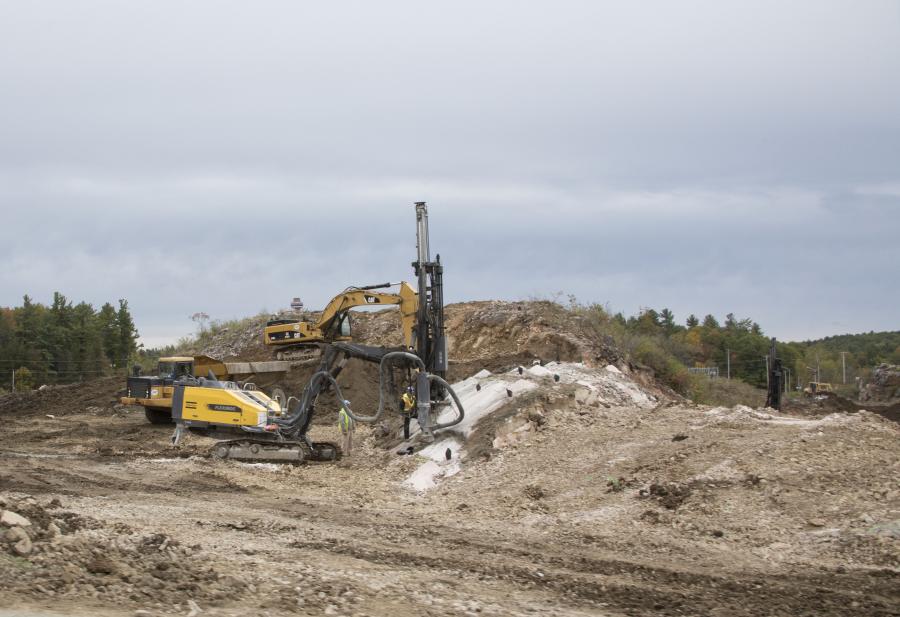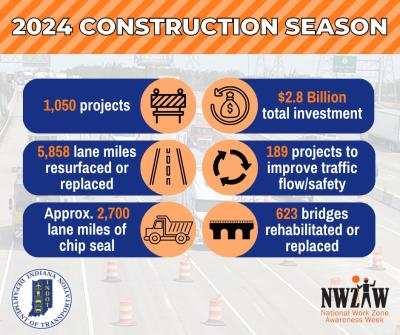As more and more people use the facility to enter the United States, upgrading and expanding the port of entry becomes a necessity.
A $215 million U.S. Land Port of Entry project under way in Alexandria Bay, N.Y., involves replacement of the port of entry with a larger and more efficient facility at the much-used U.S.-Canada border crossing.
“The project is a complete modernization and expansion of the port,” said Alison Kohler, regional public affairs officer for region 2 of the U.S. General Services Administration.
“All existing buildings will be demolished and replaced by new facilities.”
The U.S. General Services Administration awarded a contract to Northland-Cianbro, a joint venture based in Pittsfield, Maine, for the facility-wide modernization and expansion of the U.S. land port of entry at Alexandria Bay.
The joint venture company was selected through competitive, negotiated procurement procedures established by Federal Acquisition Regulation.
Construction began in August 2017. The project is expected to be fully completed in July 2022.
As more and more people use the facility to enter the United States, upgrading and expanding the port of entry becomes a necessity.
Major contractors for the project include North Central Mechanical of St. Marys, Pa., for plumbing and heating, ventilation and air conditioning; Matco Electric Corp. of Vestal, N.Y., for electric work; Rifenburg Construction of Troy N.Y., for site work, earth work, utilities and wetlands; JBS Dirt Inc. of Canastota, N.Y., for excavating; Maine Drilling & Blasting of Gardiner, Maine, for blasting; and Sessler Wrecking of Waterloo, N.Y., for building demolition and lead abatement.
JBS Dirt Inc. and Maine Drilling & Blasting are subcontractors of Rifenburg Construction.
Prep Work
Currently, 35 to 40 workers are on the job daily. Most of the work is under way south of the existing facility, preparing the new port of entry site for construction.
Work is focused on rock excavation including blasting and crushing, earthwork, storm water management and wetland mitigation.
Construction of the new commercial inspection building foundation will follow.
Heavy equipment at the construction site includes excavators, loaders, bulldozers, rollers and dump trucks. A rock crusher also is being used onsite and the blasting contractor is using remote-operated surface drillers.
At peak construction, the number of daily workers is projected to increase to 150, representing a variety of trades.
Most of the construction will require heavy use of concrete. About 7,900 cu. yds. of cast-in-place concrete will used in Phase I and 17,100 cu. yds. in Phase II.
Metal also will be in high usage, Kohler said.
Addressing Heavier Traffic
The project will address traffic issues by expanding the queuing area; increasing the number of primary inspection lanes; enlarging the area for secondary inspection; providing safe and secure vehicle parking; and building a safe well-defined truck queuing and maneuvering area.
The new facility includes 14 new primary lanes, all equipped to process passenger traffic. Eight of the lanes will also be equipped for both commercial and passenger vehicles.
“This is an increase of five passenger lanes and five commercial lanes as compared to that of the existing facility,” said Timothy Walker, U.S. Customs and Border Protection Area port director. “With the increase in inspection lanes, new technology and a better infrastructure, it will reduce delay and improve traffic flow.”
Two Phases
Phase I is under way and is expected to be completed in January 2020.
“Phase II construction start is subject to receipt of appropriations as proposed in President Trump's fiscal year 2018 budget,” said Kohler.
As part of Phase I crews will construct a commercial inspection warehouse with inspection bays and commercial inspection lanes with split-level booths for either commercial or non-commercial inspections. They will build a new veterinary services building and impound lot.
Phase I also includes acquisition of two remaining necessary parcels of land.
The existing commercial warehouse consists of a 3,000-sq.-ft. loading dock area and a double-wide trailer. The new commercial building and warehouse will span about 60,000 sq. ft.
New Facilities
In Phase II workers will build a new main administration building; a new outbound inspection facility; a new veterinary services building; non-commercial inspection lanes; a new non-commercial secondary inspection plaza; new non-intrusive inspection buildings; and employee and visitor parking areas.
The existing 46,000-sq.-ft. main administration building will be replaced with 65,000-sq.-ft. building.
Phase II construction includes a commercial inspection building and warehouse with eight docks; a new maintenance building; seven new split-level booths; canopy and inspection lanes for both commercial and noncommercial primary inspection; seven non-commercial vehicle inspection lanes; one new bus lane; a new export control building; and associated traffic lanes and a new livestock processing (veterinary services) facility.
Livestock being brought across the border include cattle, ducks, pigs and horses. Other agricultural products crossing at Alexandria Bay include potatoes, lettuce, yeast and corn.
Along with agricultural products, truck drivers cross the border carrying factory products including aluminum, steel wire, car parts, rolls of paper and Styrofoam.
Modernization, Expansion
The existing port of entry was not adequate for present and future needs. It is simply too small for a modern-day border crossing.
“The port of Alexandria Bay is a busy northern land border crossing,” Walker said. “Last year, CBP processed more than 200,000 commercial vehicles and just over 590,000 passenger vehicles.”
Most people crossing in passenger vehicles are tourists traveling from the Ottawa, Kingston, Toronto and Montreal regions who are destined to many locations throughout the United States. The port also processes travelers who cross the border for business activities in the surrounding area.
Business travelers include nurses, doctors, professors and service technicians.
Walker added that the Alexandria Bay port of entry is more than 40 years old.
“Given CBP's primary mission to protect our borders and communities, providing our officers with a modern facility is critical to ensure they are best able to complete that mission.”
The existing Alexandria Bay Land Port of Entry did not meet the current and future operational needs of the inspection agencies at the port. The lack of an adequate commercial cargo inspection facility was hampering the safe and secure execution of U.S. Customs and Border Protection and other tenant agencies' missions.
The short distance between the international border and the primary commercial inspection area was inadequate for vehicle queuing. Given the capacity of the U.S.-bound bridges and roadways, the Thousand Island Bridge Authority currently limits the number of vehicles in Canada that can proceed through to the crossing. The result is significant queuing of commercial vehicles on the Canadian roadways entering the crossing and sometimes back to Highway 401.
The bridges are not designed to handle prolonged periods of dead load associated with stationary commercial traffic. In addition, the removal of significant amounts of rock is necessary to allow for increased program and vehicle circulation.
Also, the existing main building did not accommodate the current and future needs of the tenants. The existing commercial building barely has enough space to unload a single truck and the office component is housed in mobile trailers.
The projected increases in traffic volume and implementation of new security procedures necessitate an increase in the port of entry workforce beyond the capacity of the existing facility.
Vital Link
The U.S. Land Port of Entry at Alexandria Bay is a vital link between the Ottawa Canada area, New York and major U.S. distribution centers.
The Alexandria Bay Land Port of Entry, also known as the Thousand Island Border Station, is located on Wellesley Island in the western straits of the St. Lawrence River. The port of entry is served by I-81, a major highway heavily traveled by both commercial and non-commercial travel.
From Canada, the highway provides direct access to major cities in the United States, including distribution centers in the Midwest and mid-Atlantic areas. The existing land port of entry consists of four primary buildings constructed in 1969.
The facility contains 52,261 usable sq. ft. of office and inspection space.
The mission of the Port of Entry is to inspect and process vehicles and individuals entering the United States from Canada. The mission is primarily carried out by the U.S. Customs and Border Protection, the Department of Agriculture's Animal and Plant Health Inspection Service, Veterinary Services and The Food and Drug Administration.
The General Services Administration owns and maintains the facility, and CBP operates it. To reduce drug traffic, the Alexandria Bay crossing makes use of drug-sniffing dogs.
“The Buffalo Field Office, which covers all of New York except New York City, employs canine teams throughout all of its ports of entry,” Walker said.
Business as Usual
Construction will have minimal impact to port operations. The new port is being built south of the existing facility.
Phase I includes demolition of the existing commercial structure and adjusting site features requiring the blasting and removal of rock. Temporary facilities will be added to accommodate port operations.
Existing roadways will be shifted, lengthened or altered to accommodate the new port operations. But no new roadways will be constructed.
Today's top stories





















